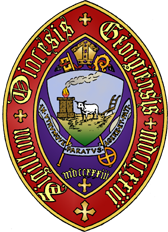The young son of a wealthy New York City family, Anson Green Phelps Dodge, Jr. (1860-1898) was sent south after the American Civil War to tour the family’s timber property on St. Simons Island. He rode out on horseback to the north end of the island and found the ruined Christ Church. Built in 1820, near the site of the oak tree under which the Wesley brothers preached, the church was virtually destroyed by Federal soldiers during the in 1862. He was so horrified by the treatment of the building and sought Holy Orders to address the problem personally. Dodge entered the General Theological Seminary to prepare to spend his life pastoring and rebuilding Christ Church as a religious community, in addition to rebuilding its building.
 The young Dodge fell in love with his younger first cousin, Ellen Ada Phelps. Their marriage in 1880 created a scandal. Eventually, the family agreed to the match. The couple planned an ambitious 3-year trip around the world as their honeymoon journey. In India, Ellen contracted cholera and died. Devastated by her death, Anson had his wife embalmed and placed in a metal coffin inside an ebony casket. He had promised her on her death bed that he would not leave her side. True to his word, he remained by her casket in the hold of the ship for a long return journey. He buried her under the altar at Frederica on his return to the Georgia coast. In time, he remarried. His second wife, Anna Gould Dodge, gave birth to a son. Their son also died tragically when he fell from a carriage at the age of three.
The young Dodge fell in love with his younger first cousin, Ellen Ada Phelps. Their marriage in 1880 created a scandal. Eventually, the family agreed to the match. The couple planned an ambitious 3-year trip around the world as their honeymoon journey. In India, Ellen contracted cholera and died. Devastated by her death, Anson had his wife embalmed and placed in a metal coffin inside an ebony casket. He had promised her on her death bed that he would not leave her side. True to his word, he remained by her casket in the hold of the ship for a long return journey. He buried her under the altar at Frederica on his return to the Georgia coast. In time, he remarried. His second wife, Anna Gould Dodge, gave birth to a son. Their son also died tragically when he fell from a carriage at the age of three.
While much of his story is told in Eugenia Price’s historical novel, The Beloved Invader, what is not so clear from the novel is his energy in riding out from St. Simons preaching to all he could gather along the coast, regardless of race, and forming them into congregations. His foundations clearly stand out in the old list of the Diocese of Georgia, because he was deeply affected by the Latin and Greek fathers of the first four centuries of the Church.
 Thus, he dedicated his new congregations to St. Ignatius, St. Cyprian, St. Ambrose, St. Perpetua, St. Athanasius, as well as to the Messiah, Transfiguration, and St. Andrew. He founded six chapels along the Satilla River. He worked as far inland as Waycross, founding the Church of St. Ambrose there.
Thus, he dedicated his new congregations to St. Ignatius, St. Cyprian, St. Ambrose, St. Perpetua, St. Athanasius, as well as to the Messiah, Transfiguration, and St. Andrew. He founded six chapels along the Satilla River. He worked as far inland as Waycross, founding the Church of St. Ambrose there.
His family fortune allowed him to financially underwrite a priest to serve some of these congregations and assist him in his work. He also restored life at what is now Christ Church in St. Marys, St. Andrew’s in Darien, (which had been burnt to the ground), and St. Mark’s in Brunswick.
Lovely Lane Chapel, now at Epworth, the Methodist Conference Center, is the church he built for the mill workers in St. Simon’s Village. His concern for the church led him to build a dorm still in use at General Theological Seminary in New York City, and a cathedral in India, which was destroyed in the India-Pakistan war. His last work was to found an orphanage in his home for boys. That work goes on as a significant endowment providing for the education of poor boys. He died at the age of 38. In keeping with his will, Ellen’s casket was removed from the vault under the altar to be buried by his side in the church yard.
